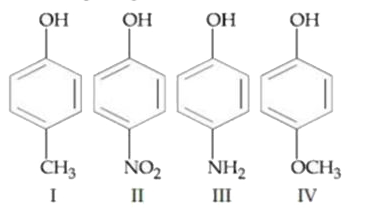Lowest boiling point will be of the compound-
2-propanamine
Ethylmethylamine
1-propanamine
N,N-dimethylmethanamine
The correct Answer is:D
To determine which compound has the lowest boiling point among the given amines, we need to analyze the structures and the ability of each compound to form hydrogen bonds. Here’s a step-by-step solution:
Step 1: Identify the Compounds
We have four amines to analyze:
1. 2-Propanamine (A)
2. Ethyl methyl amine (B)
3. 1-Propanamine (C)
4. Dimethylamine (D)
Step 2: Draw the Structures
- 2-Propanamine (A): This is a secondary amine with the structure:
CH3−CH(NH2)−CH3
- Ethyl methyl amine (B): This is also a secondary amine with the structure:
CH3−CH2−NH−CH3
- 1-Propanamine (C): This is a primary amine with the structure:
CH3−CH2−CH2−NH2
- Dimethylamine (D): This is a tertiary amine with the structure:
(CH3)2−NH
Step 3: Analyze Hydrogen Bonding
- Hydrogen Bonding Capability:
- Compounds A, B, and C can form hydrogen bonds because they have at least one hydrogen atom attached to the nitrogen atom.
- Compound D (Dimethylamine) does not have any hydrogen atoms attached to nitrogen, which means it cannot form hydrogen bonds.
Step 4: Determine Boiling Points
- Compounds that can form hydrogen bonds typically have higher boiling points due to the additional intermolecular forces.
- Since compound D cannot form hydrogen bonds, it will have the lowest boiling point among the four.
Conclusion
The compound with the lowest boiling point is Dimethylamine (D).
Final Answer
Option D (Dimethylamine) has the lowest boiling point.
---
We have four amines to analyze:
1. 2-Propanamine (A)
2. Ethyl methyl amine (B)
3. 1-Propanamine (C)
4. Dimethylamine (D)
- 2-Propanamine (A): This is a secondary amine with the structure:
CH3−CH(NH2)−CH3
- Ethyl methyl amine (B): This is also a secondary amine with the structure:
CH3−CH2−NH−CH3
- 1-Propanamine (C): This is a primary amine with the structure:
CH3−CH2−CH2−NH2
- Dimethylamine (D): This is a tertiary amine with the structure:
(CH3)2−NH
- Hydrogen Bonding Capability:
- Compounds A, B, and C can form hydrogen bonds because they have at least one hydrogen atom attached to the nitrogen atom.
- Compound D (Dimethylamine) does not have any hydrogen atoms attached to nitrogen, which means it cannot form hydrogen bonds.
- Compounds that can form hydrogen bonds typically have higher boiling points due to the additional intermolecular forces.
- Since compound D cannot form hydrogen bonds, it will have the lowest boiling point among the four.
The compound with the lowest boiling point is Dimethylamine (D).
Option D (Dimethylamine) has the lowest boiling point.
Topper's Solved these Questions
- ALKENE, ALKANE & ALKYNE BOOK - ALLENCHAPTER - ALKENE, ALKANE & ALKYNE EXERCISE - EXERCISE-2
103 Videos
- ALKENE, ALKANE & ALKYNE BOOK - ALLENCHAPTER - ALKENE, ALKANE & ALKYNE EXERCISE - EXERCISE-3
99 Videos
- ALKENE, ALKANE & ALKYNE BOOK - ALLENCHAPTER - ALKENE, ALKANE & ALKYNE EXERCISE - EXCERSISE-3
28 Videos
- AIIMS 2019BOOK - ALLENCHAPTER - AIIMS 2019EXERCISE - CHEMISTRY
40 Videos
- ALKYL AND ARYL HALIDEBOOK - ALLENCHAPTER - ALKYL AND ARYL HALIDEEXERCISE - EXERCISE-05 (B)
35 Videos
Similar Questions
Knowledge Check
Assertion: The boiling point of the compounds increases in the order:
Isopropylchloridelt1-Chloropropane,1-Chlorobutane. ltbr> Reason: Boiling point depends upon the molecular mass and surface area.AIf both assertion and reason are true and reason Is the correct explanation of assertion.BIf both assertion and reason are true but reason is not the correct explanation of assertion.CIf assetion is true but reason is false.DIf both assertion and reason are false.
Define boiling point
View SolutionExplain the following:
lonic compounds have high melting point and boiling point while covalent compounds have low melting and boiling points.
View SolutionCorrect order of boiling point of the given compounds is
View SolutionBoiling point is highest for which compound?
View SolutionThe increasing order of boiling points of the folloiwng compounds is :

View SolutionThe decreasing order of boiling points of the following compounds is:
(I)
View SolutionHighest boiling point is expected for
View Solution
